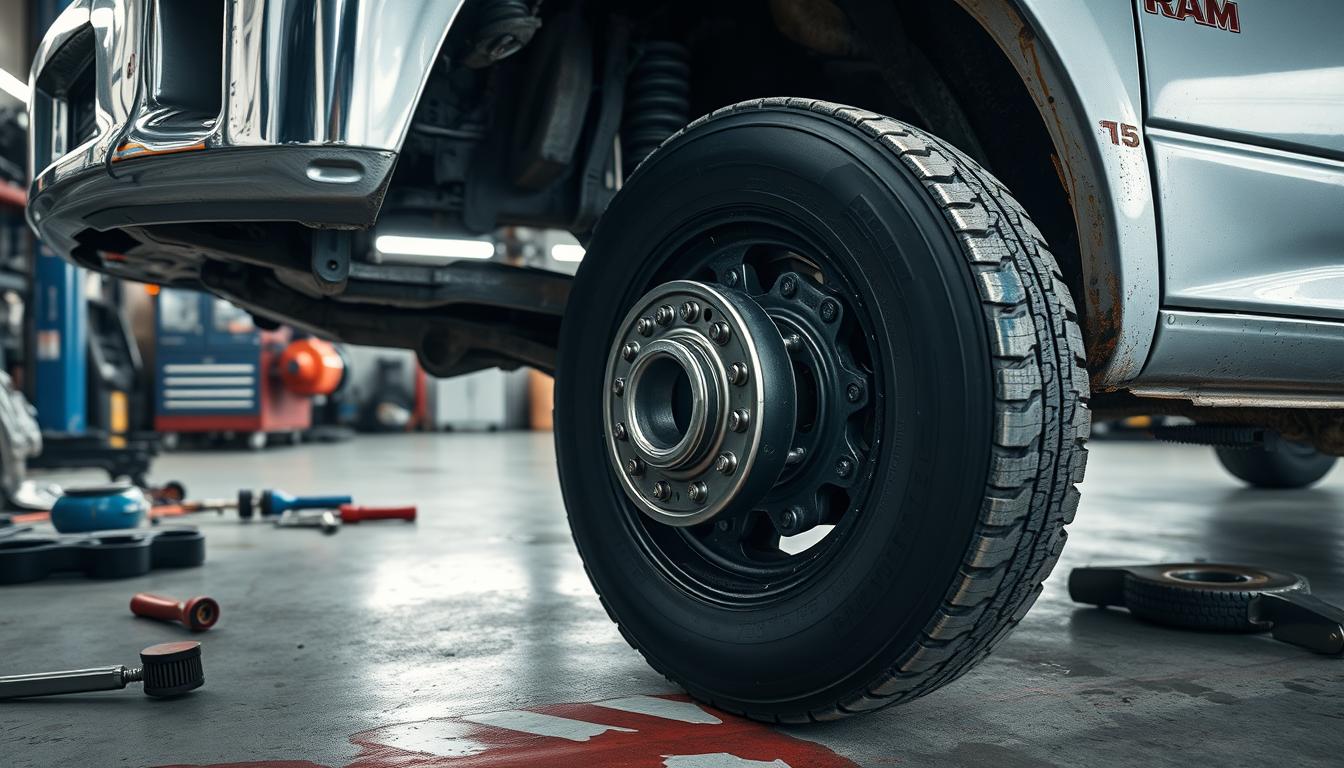If you own a Dodge Ram 1500, keeping it safe and running well is key. The front wheel bearing is a critical part to keep up. Replacing it regularly, known as Dodge Ram 1500 Front Wheel Bearing Replacement, is vital. It helps your car run smoothly and lasts longer.
This Dodge Ram Wheel Bearing Repair Guide will show you how to do it. You’ll learn what a front wheel bearing is and how to put in a new one. By following this guide, you’ll not only replace the bearing but also understand your car better.
Key Takeaways
- Regularly replace wheel bearings every 85,000 to 100,000 miles for safety.
- Ensure lug nuts are torqued to 130 lb-ft in a criss-cross pattern.
- Properly torque new hub assembly bolts to 134 lb-ft during installation.
- Use essential tools like a 36MM socket and a torque wrench for the job.
- Purchase quality replacement parts to ensure longevity.
- Remember to check alignment after completing the replacement.
Understanding the Front Wheel Bearing
The front wheel bearing is key for your car’s performance. It lets the wheels turn smoothly, helping with steering and braking. Knowing when to maintain it is important for safe driving.
What is a Wheel Bearing?
A wheel bearing helps the wheel hub turn, letting the wheel spin without much friction. It’s crucial for how well your car handles and performs. Keeping wheel bearings in good shape can make your car last longer.
Signs of a Bad Wheel Bearing
Knowing the Symptoms of Failing Wheel Bearings is vital. Look out for:
- Unusual noises like grinding or humming
- Vibrations or shaking in the steering wheel
- Looseness or play in the wheels when rocked
If you see these signs, it’s time to check the wheel bearings. This can prevent bigger problems and keep you safe.
Importance of Timely Replacement
The Importance of Wheel Bearing Maintenance is huge. Replacing them every 85,000 to 100,000 miles keeps your car running right. Not doing this can cause bigger issues, like brake or suspension problems.
Tools and Equipment Needed
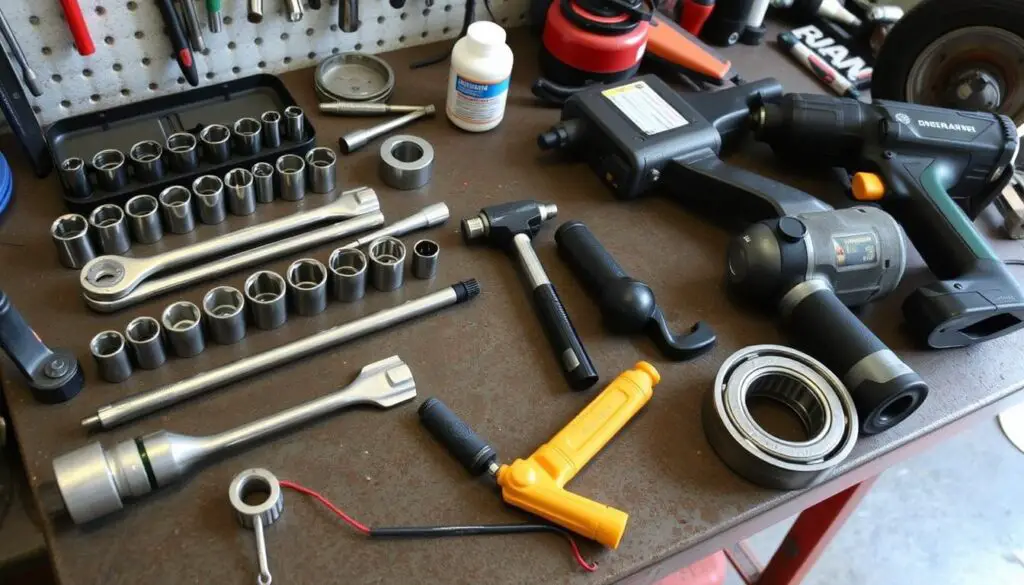
Changing the front wheel bearing on a Dodge Ram 1500 needs the right tools. The correct equipment makes the job safer and more efficient. It’s important to have everything you need before starting.
Essential Tools List
- Jack
- Jack stands
- Socket set
- Lug wrench
- Replacement wheel bearing assembly
These tools are key for fixing your Dodge Ram 1500. A jack is vital, as most cars come with one. It helps lift the wheel safely. You’ll also need a socket set and a lug wrench to handle different parts.
Optional Tools for Ease
- Puller tool
- Air impact gun
- Rubber mallet
While basic tools are enough, extra tools can make things easier. For example, 70% of cars need special tools for hard-to-reach bolts. These tools help with tough jobs, making maintenance easier.
Safety Gear Recommendations
- Gloves
- Safety goggles
Keeping safe is crucial when doing DIY repairs. Wear gloves and safety goggles to protect yourself. They help prevent injuries when working with heavy or dangerous parts.
Preparing Your Dodge Ram 1500
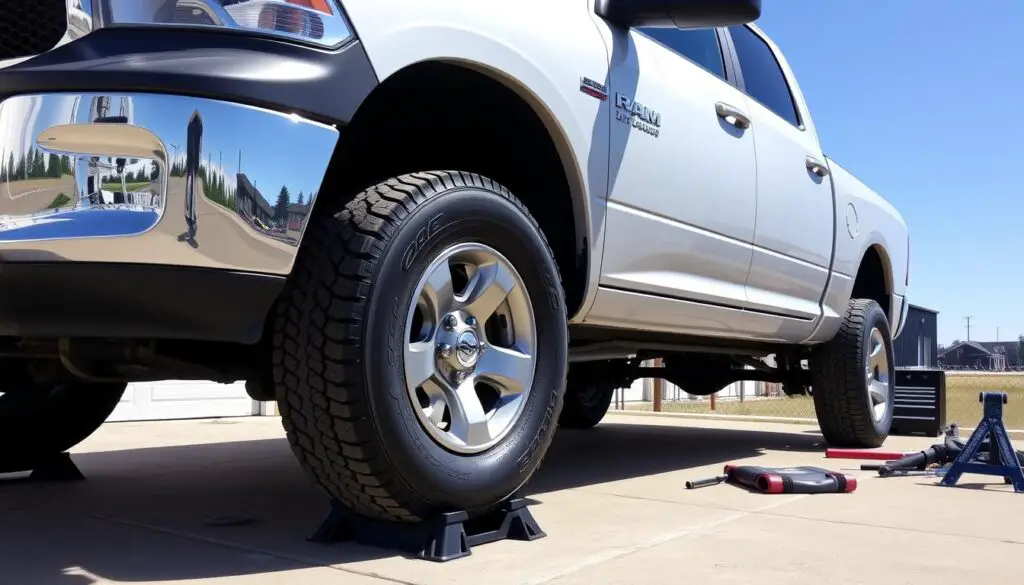
It’s important to secure and lift your Dodge Ram 1500 right for a successful wheel bearing replacement. This keeps you safe and makes the job easier. First, check the ground and pick the best spot for lifting tools.
Securing the Vehicle
To secure Dodge Ram for maintenance, park on a flat, stable surface. This helps avoid the vehicle rolling or slipping. Next, lock the parking brake and put wheel chocks behind the rear wheels.
Then, take off the hubcap or wheel cover. This makes it easy to get to the lug nuts.
Lifting the Vehicle Safely
Using safe vehicle lifting techniques is key. Lift the front of the truck with a jack until the tires are off the ground. Always use jack stands under the frame for extra support.
This keeps you safe while you replace the wheel bearing. Never lift a vehicle on a jack alone. It can cause serious harm. Always follow these steps:
- Check the jack and jack stands for damage.
- Make sure the jack is under the right spots.
- Never work under a vehicle on a jack alone.
| Action | Description |
|---|---|
| Find Stable Ground | Park on flat, dry surfaces to prevent slipping. |
| Engage Parking Brake | Ensure the vehicle remains stationary while working. |
| Use Wheel Chocks | Block rear wheels to avoid any rolling. |
| Lifting with Jack | Raise the vehicle using a jack, then add jack stands for safety. |
| Secure Jack Stands | Always place jack stands under the vehicle frame, never under the control arms. |
By following these steps, you’ll make a safe space to start your wheel bearing replacement. Always put safety first for a better maintenance experience.
Removing the Wheel
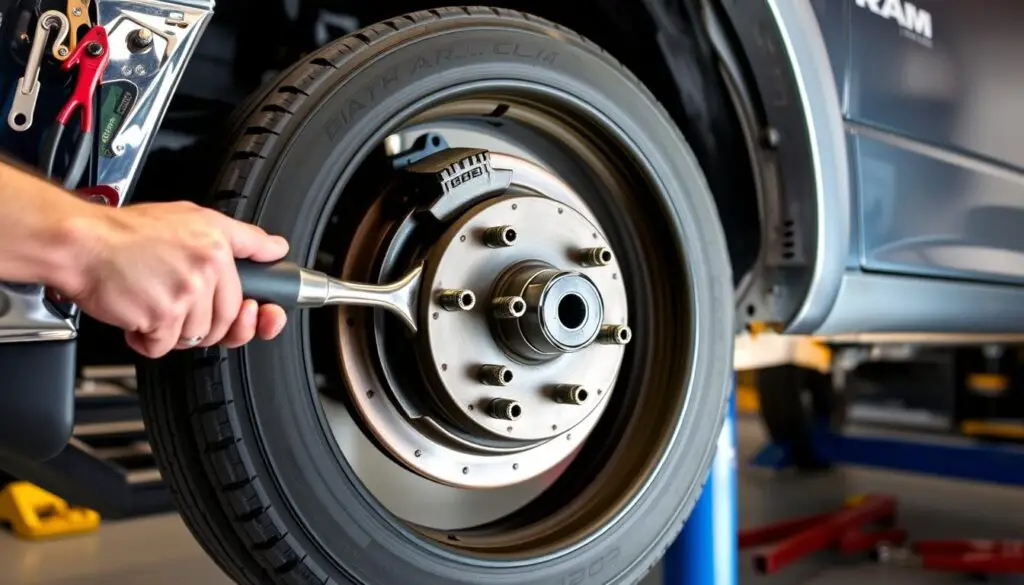
Removing the Dodge Ram wheel is key for any repair or maintenance. It’s important to do it right to move forward safely and efficiently. Each step is crucial for a successful project.
Loosening Lug Nuts
First, loosening lug nuts competently is vital. Use a 7/8 socket or a 22-mm socket with a breaker bar for extra power. Apply steady pressure to loosen each lug nut counterclockwise.
For safety and efficiency, follow this order:
- Loosen the lug nuts slightly while the wheel is still on the ground.
- Once loose, lift the vehicle for further accessibility.
- Fully remove the lug nuts once the vehicle is elevated.
Taking Off the Wheel
After loosening the lug nuts, it’s time to remove the wheel. Make sure the vehicle is secure and supported by jack stands. Remove the lug nuts and set them aside neatly.
Gently pull the wheel straight off the hub assembly. Be careful not to damage anything. It’s wise to store the wheel properly to keep your area clean and safe.
By following these steps, you’re ready to access the front wheel bearing. Keep your workspace clean to stay efficient.
Accessing the Front Wheel Bearing
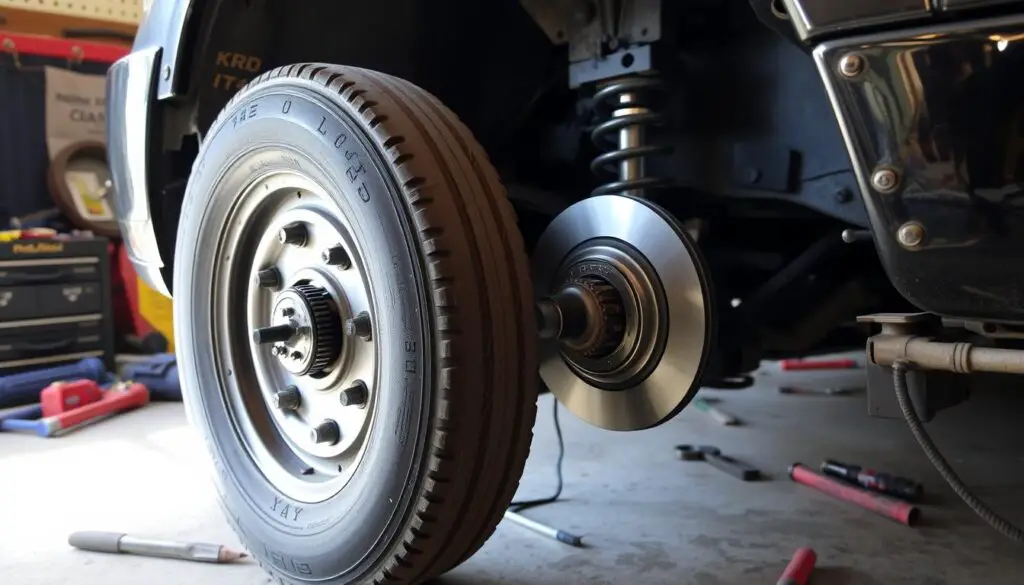
To get to the front wheel bearing on a Dodge Ram 1500, follow some key steps. First, find the bearing assembly. Then, remove the brake caliper. This way, you can replace the bearing without any issues.
Locating the Bearing Assembly
Start by taking off the wheel to see the bearing assembly. Use a 7/8 socket or a 22-mm socket to loosen the lug nuts. After removing the wheel, look at the brake parts. You’ll find the bearing assembly behind the brake rotor.
Removing the Brake Caliper
Next, you need to remove the brake caliper. This is a crucial part of getting to the wheel bearing. Use a 13-mm socket to remove the caliper bolts. To keep the brake lines safe, hang the caliper with a wire or hanger. This step helps you work on the bearing without damaging anything.
Removing the Brake Rotor
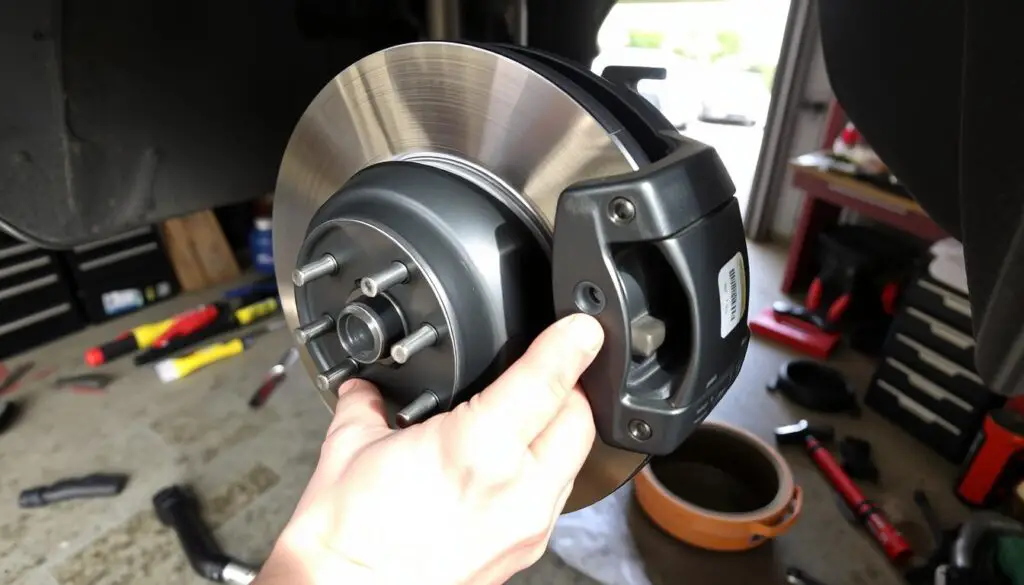
Removing the brake rotor is key for good brake replacement. It needs careful steps, mainly for hard-to-remove rotors. A smooth removal lets the new rotor fit right.
Detaching the Rotor
To remove the brake rotor on your Dodge Ram, follow these steps. First, take off the brake caliper as shown before. Then, detach the rotor:
- Look for screws or clips holding the rotor; use the right tool to remove them.
- Try to wiggle the rotor to see if it comes off; watch for any hard spots.
- If it doesn’t budge, use penetrating oil to loosen rust or corrosion. Let it sit for a bit.
- If it’s still stuck, tap it gently with a hammer to help it come off.
Tips for Stubborn Rotors
For hard-to-remove rotors, here are some tips:
- Put penetrating oil around the rotor’s edges to loosen corrosion.
- Use a wire brush to clean rust from the hub area.
- Tap the rotor with a hammer carefully to avoid damage.
- Use a puller tool for rotor removal to apply even pressure.
By following these steps, you can remove the rotor well. This makes installing new brake parts easier. Learning these methods improves your vehicle’s safety.
Extracting the Old Wheel Bearing
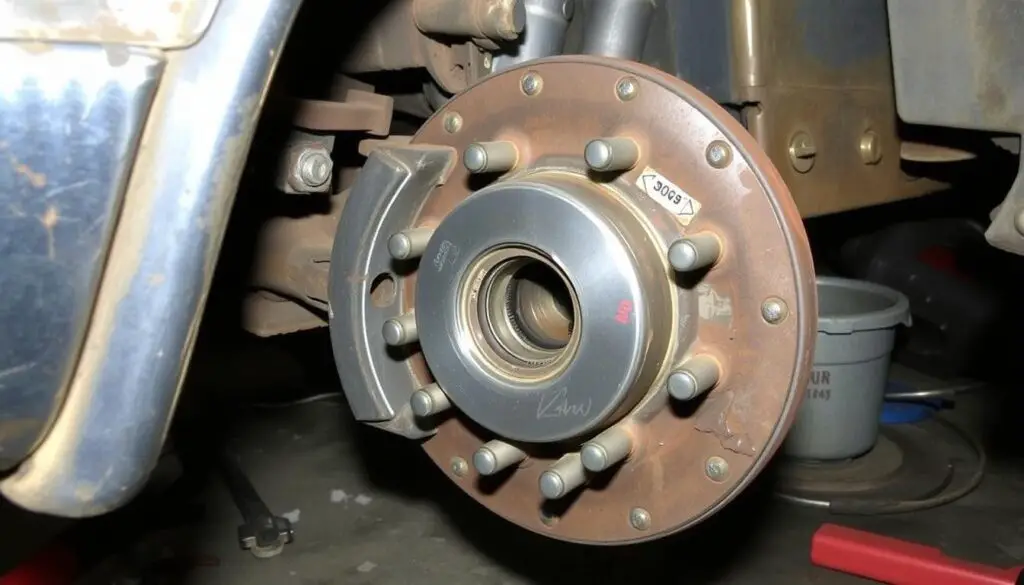
Removing the old wheel bearing is a key step. It needs careful attention to avoid damage. You must identify the Dodge Ram Bearing Bolts and use the right tools to remove them.
Identifying Bearing Bolts
Before you start, find the right bolts. These include:
- Hub bolts
- Caliper bolts
- Cotter pin and castle nut
Knowing these parts makes disassembly and reassembly easier. Labeling them helps a lot.
Using a Puller Tool
If the bearing won’t come off, use a puller tool. It helps remove the bearing without harming the wheel knuckle. Here’s how to use it:
- Attach the puller tool to the bearing.
- Make sure the puller’s arms are around the bearing.
- Slowly turn the center bolt for even pressure.
If the bearing is hard to remove, a little tap with a hammer might help. Always wear safety gear to protect yourself.
After removing the old bearing, clean the knuckle area. This step is crucial for a smooth new bearing installation. It ensures a quieter ride afterwards.
Installing the New Wheel Bearing
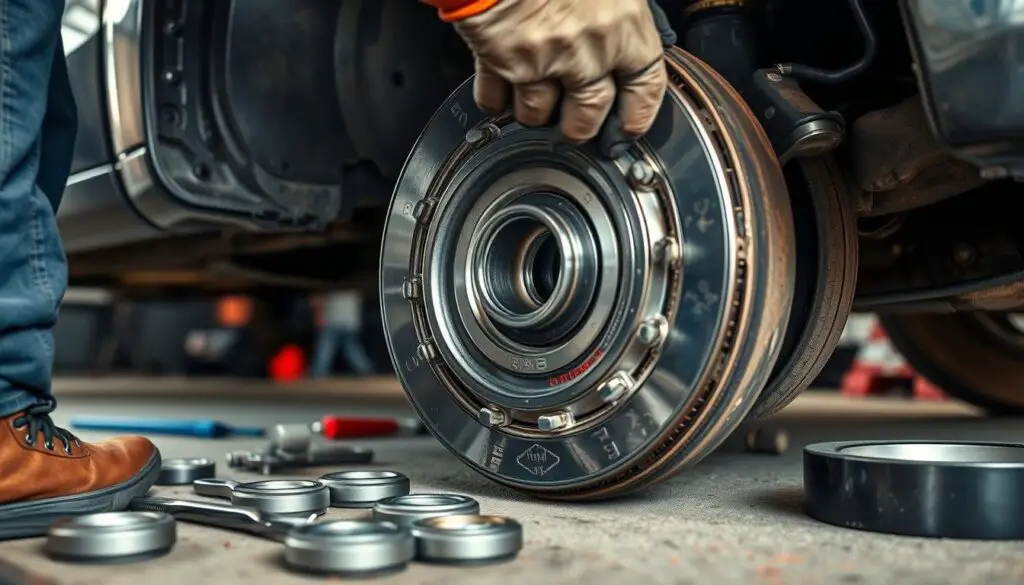
Installing a new wheel bearing in your Dodge Ram needs careful planning. Choosing the right wheel bearing is key for your vehicle’s performance. Here’s how to replace it successfully.
Choosing the Right Replacement
First, pick the right replacement for your Dodge Ram 1500. Quality is important to avoid early failure. Look for brands like Moog and Precision Products, which vary in price.
| Brand | Price |
|---|---|
| Precision Products | $239 |
| Advanced Auto | $289 |
| Dealer | $350 |
| Amazon Moog | $139 |
Step-by-Step Installation
Start the step-by-step bearing installation with a clean area. Follow these steps for a perfect fit:
- Make sure the hub area is clean and free of old grease.
- Put the new wheel bearing in the hub.
- Secure the hub with three bolts at 134 lb-ft.
- Tighten the lower ball joint nut to 40 lb-ft.
- Use 185 lb-ft torque for the axle nut.
- Secure the caliper bracket bolts at 130 lb-ft each.
- For the outer tie rod end nut, apply 22 lb-ft torque and turn 90° more.
- When putting back the wheel, tighten lug nuts to 130 lb-ft in a criss-cross pattern.
By following these steps and keeping torque specs in mind, you’ll get a reliable and long-lasting installation for your Dodge Ram 1500.
Reassembling the Brake Components
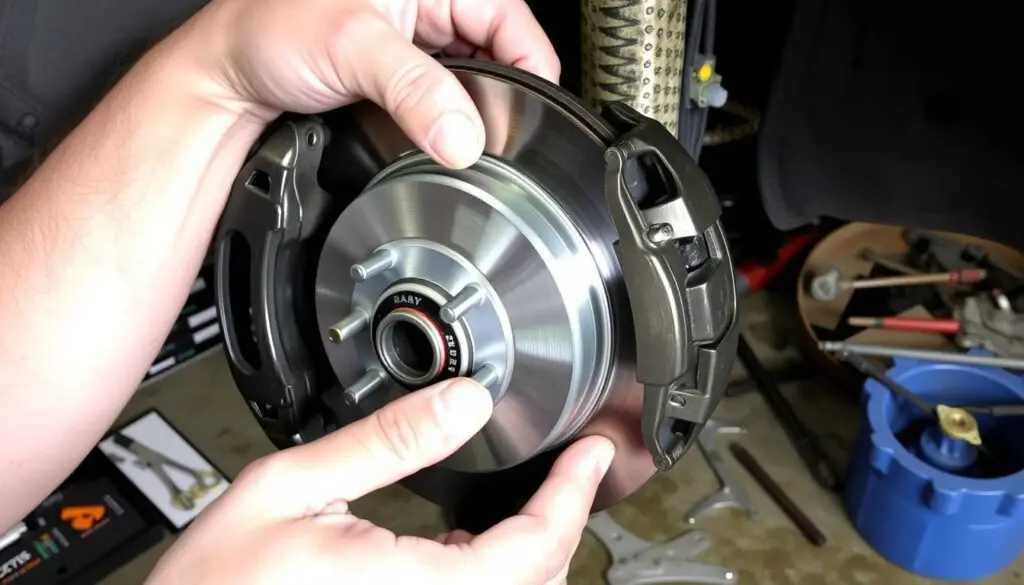
After replacing the wheel bearing on your Dodge Ram 1500, it’s time to Reassembling Dodge Ram Brake Components. This is key for a safe and reliable brake system. Make sure to attach the brake rotor and install the brake caliper correctly.
Reattaching the Brake Rotor
Start by placing the brake rotor on the wheel hub. It should fit snugly without any gaps. Use these Brake Rotor Attachment Techniques for the best results:
- Clean the mounting surface: This keeps it free from dirt.
- Locate the rotor screws: Put them back or replace them to hold the rotor.
- Torque specifications: Tighten the screws as the maker suggests to avoid problems later.
Reinstalling the Brake Caliper
For Brake Caliper Reinstallation, follow these steps:
- Align the caliper: Place it right over the rotor.
- Insert the caliper bolts: Use threadlocker for extra security.
- Torque settings: Tighten the bolts to 38 lb-ft for a tight fit.
After putting the brake caliper back, check its alignment and fasteners. This ensures your truck brakes well and lasts longer. A good reassembly means safer driving.
| Component | Torque Specification |
|---|---|
| Caliper Bolts | 38 lb-ft |
| Hub Nut | 185 lb-ft |
| Lug Nuts | 110 lb-ft |
Replacing the Wheel
After installing the new front wheel bearing, it’s time to replace the wheel. This step is key for your vehicle’s safety and performance. It involves correct wheel positioning and tightening lug nuts right.
Positioning the Wheel Properly
When putting on a new Dodge Ram wheel, align it well with the hub. Make sure the bolt holes of the wheel match those of the hub. Push the wheel onto the hub until it’s even.
This step is crucial for a secure fit. It helps avoid problems later on.
Tightening the Lug Nuts
After aligning the wheel, tighten the lug nuts. Use a torque wrench to tighten to 130 lb-ft. Tighten in a criss-cross pattern to spread the pressure evenly.
This method strengthens the wheel’s attachment. It also reduces the chance of the lug nuts coming loose while driving.
Final Checks
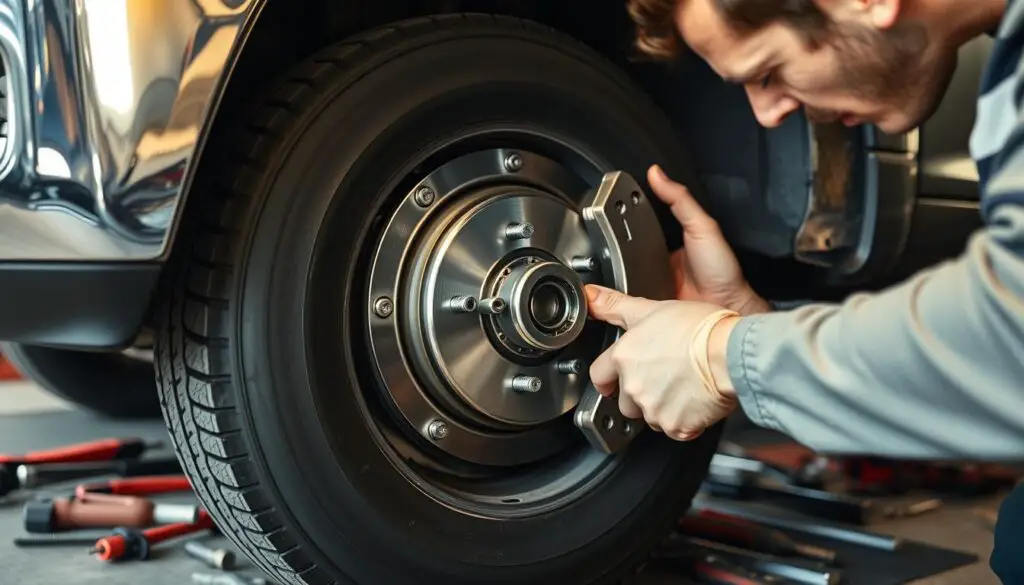
After you replace the wheel bearing, it’s important to double-check everything. These final checks ensure your Dodge Ram 1500 is safe and runs well.
Inspecting Your Work
Start by checking if all parts are well-attached. Look at these points:
- Hub assembly bolts should be torqued to 149 ft. lbs..
- Caliper mount bolts need a torque of 250 ft. lbs..
- Caliper bolts must be tightened to 24 ft. lbs..
- Make sure the axle nut is first torqued to 150 ft. lbs. and then to 263 ft. lbs. after spinning the wheel.
- Use a 1 1/16 socket and a T45 Torx socket for this.
Checking Wheel Alignment
Then, focus on the importance of wheel alignment. Proper alignment is key for smooth driving:
- Pump the brakes until the caliper pistons extend before driving.
- Make sure lug nuts are torqued to 130 lb-ft in a criss-cross pattern.
- Check that all parts, like the tie rod end nut and caliper bracket bolts, are securely fastened.
Replacing wheel bearings is a crucial maintenance task. It’s recommended every 85,000 to 100,000 miles. Aftermarket parts can last longer, making your vehicle more durable.
Testing the Vehicle
After replacing the wheel bearings on your Dodge Ram 1500, it’s key to test it well. A test drive helps see how the truck does under normal use. Drive in different places, like parking lots and highways, to check its performance.
Taking a Test Drive
When you test drive, notice how the truck feels. The steering should be smooth, and the wheel shouldn’t vibrate or feel loose. This is also a chance to check if the torque specs were followed right.
Wheel bearings usually need to be replaced every 85,000 to 100,000 miles. This test reminds you of when it’s time for maintenance.
Listening for Unusual Noises
While driving, listen for odd sounds from the wheels. Hearing grinding, humming, or clicking might mean the new bearing isn’t right or there’s another problem. Catching these early helps keep your Dodge Ram 1500 safe and running well.
FAQ
How often should I replace the front wheel bearings on my Dodge Ram 1500?
What tools do I need for changing the front wheel bearing on my Dodge Ram 1500?
What are the symptoms of a bad front wheel bearing?
Is it safe to drive with a bad wheel bearing?
Can I change the front wheel bearing myself?
What safety precautions should I take when replacing the front wheel bearing?
How do I know if the wheel bearing installation was successful?
Can rust affect the wheel bearing replacement?
What torque specifications should I follow when reassembling?
How can I maintain my Dodge Ram’s front wheel bearings?

Jack Thompson is a writer and seasoned auto mechanic with over 15 years of experience in the automotive industry. Known for his expertise in vehicle mechanics, Jack has a deep understanding of car and truck systems. His skills, honed through years of hands-on experience, have made him a trusted name in the field. Jack is committed to providing valuable insights into car maintenance and repair, helping vehicle owners keep their vehicles in top condition.

